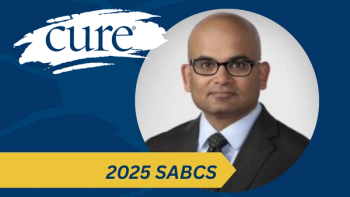
Combination Continues to Show Impressive Outcomes in Melanoma
In an interview with CURE, Postow, a medical oncologist specializing in melanoma at Memorial Sloan Kettering Cancer Center, discussed the impressive efficacy seen with combining BRAF and MEK inhibitors for patients with melanoma.
Michael A. Postow, M.D.
The combination of Tafinlar (dabrafenib) and Mekinist (trametinib) — a BRAF and a MEK inhibitor, respectively – showed promising results in patients with BRAF-mutant, stage 3 melanoma. The pair reduced the risk of relapse or death by 53 percent, comparted to placebo, according to findings from the phase 3 COMBI-AD study.
“We see better efficacy with combinations, particularly with BRAF/MEK inhibitors, over BRAF inhibitors alone,” said Michael A. Postow, M.D. “The overall survival was improved in that group of patients [treated with Tafinlar and Mekinist].”
After a median follow-up of 2.8 years, the three-year relapse-free survival rate with the combination versus placebo was 58 percent versus 39 percent, respectively.
Early data for the overall survival (OS) benefit showed that 86 percent of the patients treated with the Tafinlar and Mekinist combination were alive at three years versus 77 percent with placebo.
What are some promising treatments in the pipeline for patients with resected stage 3 melanoma?
In an interview with CURE, Postow, a medical oncologist specializing in melanoma at Memorial Sloan Kettering Cancer Center, discussed the impressive efficacy seen with combining BRAF and MEK inhibitors for patients with melanoma.Most of the treatments that are effective for resected stage 3 melanoma are drugs that have been shown to already be beneficial for patients with stage 4 melanoma or unresectable stage 3 melanoma. For example, drugs such as PD-1 antibodies or BRAF and MEK inhibitors, either alone or in combination.
Can you discuss the efficacy of combining BRAF and MEK inhibitors?
Now that we have seen efficacy of those drugs in unresectable stage 3 and 4 patients, we now have evidence that they can help treat earlier stage melanoma, resected stage 3 melanoma, or what I call the “invisible enemy” for patients who have melanoma that you cannot see on scans but, unfortunately, know is present.We have two BRAF and MEK studies that have been presented so far for stage 3 resected patients. The patient population was different in each of the studies. One was called the BRIM8 study, which tested Zelboraf (vemurafenib) versus placebo. The other is for patients with stage 3 melanoma called the COMBI-AD study. That tested Tafinlar plus Mekinist versus placebo for patients with stage 3 resected melanoma.
Both studies had interesting biologic effects demonstrating efficacy of both single-agent BRAF inhibition and the combination of BRAF/MEK inhibition with Tafinlar and Mekinist for patients with resected stage 3 melanoma. The recurrence-free survival was improved for the BRAF/MEK inhibitor combination therapy with Tafinlar and Mekinist for these patients.
Do you envision the future treatment landscape to be with combinations, or will single agents still play a role?
It also looked like the OS was improved in that group of patients. There were some caveats on the way some of the statistics were preformed, but we are seeing a benefit. There are clearly biologic effects of both single-agent BRAF inhibition with Zelboraf, and [combination activity] Tafinlar and Mekinist in this population of patients with resected high-risk BRAF-mutant melanoma. In this patient population, many have been cured from surgery alone. We are hoping to do the best we can with efficacy and minimal toxicity. These patients do not have obvious disease and they may have been cured from surgery. However, as we have seen in the metastatic landscape, we see better efficacy with combinations, particularly with BRAF/MEK inhibitors over BRAF inhibitors alone. I am hopeful that combinations can also translate to more efficacy in this micrometastatic setting.
What other challenges would you like to see addressed in the next five to 10 years?
It is important to be mindful of toxicity in this group of patients, many of whom are already cured from surgery. However, after seeing the efficacy improvements in stage 4, we will hopefully see the same results in stage 3. We just need to be careful on how we do studies. One of the biggest challenges in this group of patients is that all of our adjuvant trials have various control arms. Some adjuvant trials are [composed of] observation control arms, whereas some have active control arms, such as the CheckMate-238 study of [adjuvant] Opdivo (nivolumab) versus adjuvant Yervoy (ipilimumab).
One of the major difficulties in interpreting these [studies] over the next three to five years is going to be how to compare across trials when we have different control arms. I am not sure that there is an answer to that type of question. We will be left with cross-trial comparisons and all those inherent caveats, but that is going to be one difference when attempting to compare them. Is it better to give a stage 3 resected patient Tafinlar and Mekinist or a single-agent PD-1 drug like Opdivo?
The other big question that remains is whether we should treat all patients in the adjuvant setting or only treat the patients who ultimately have recurrent disease with these agents in the stage 4 setting? The majority of these adjuvant trials have not allowed crossover, and, therefore, we do not know if we should give the treatment now or later to only those patients who we really need to treat.
There are many ongoing questions and I am hopeful we will get more information as we see longer follow-up.




